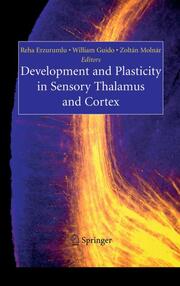Detailansicht
Developement & Plasticity in Sensory Thalamus & Cortex
ISBN/EAN: 9780387317984
Umbreit-Nr.: 1913659
Sprache:
Englisch
Umfang: xiv, 322 S., 36 s/w Illustr., 29 farbige Illustr.,
Format in cm:
Einband:
gebundenes Buch
Erschienen am 01.08.2006
- Zusatztext
- InhaltsangabePioneer neurons and interneurons in the developing subplate: molecular markers, cell birthdays, and neurotransmitters.- Dual roles of transcription factrs in forebrain morphogenesis and development of axonal pathways.- Subcortical and neocortical guidance of area-specific thalamic innervation.- The earliest thalamocortical interactions.- Molecular basis for the formation of lamina-specific thalamocortical projections.- Role of Citron K in the development of Cerebral Cortex.- The absence of layer 4 dramatically alters cortical development in ferret somatosensory cortex.- Influence of thalamocortical activity on sensory cortical development and plasticity.- Pathways to barrel development.- Patterning of the somatosensory maps with NMDA receptors.- Presynaptic signaling mechanisms controlling axon arbor remodeling in the thalamocortical and retinogeniculate systems.- Cellular mechanisms underlying the remodeling of retinogeniculate connections.- A model for synaptic refinement in visual thalamus.- Making and breaking eye-specific projections to the lateral geniculate nucleus.- LTD as a mechanism for map plasticity in rat barrel cortex.- High-Field (9.4T) magnetic resonance imaging in squirrel Monkey.
- Kurztext
- Our brain evolved in a manner to enable itself to modify its structure depending on its environment. The thalamus is a large sensory relay station and it is closely integrated into the cortical circuits. Thalamic projections are responsible for dispatching most of the information to the cortex from the sensory periphery from early stages throughout life. The earliest inputs to the cortex are capable of constituting an extrinsic signal that plays a part in triggering other changes in the establishing cortical circuitry, leading to some aspects of specific regional differentiation and a real specializations. Unravelling the mechanism by which developing thalamic axons interact with the forming cortical circuitry in their target regions is important in understanding how cortical organization is determined. This book intends to bring together systems and molecular approaches on various fundamental issues on thalamocortical development and plasticity. Functional cortical circuits cannot be appreciated without thalamocortical circuits and cortical development cannot be considered without thalamocortical pathway development. The 16 chapters address key questions with diversity of techniques; ranging from molecular genetics, in vitro and in vivo methods to classical anatomical, electrophysiological and imaging procedures. The conceptual approaches formulated in these chapters should be a rich source for future research in this area.
